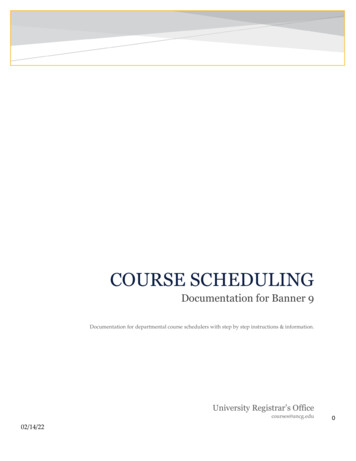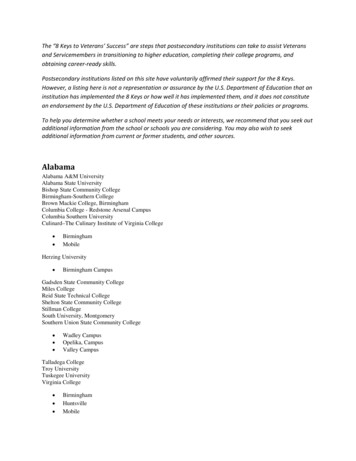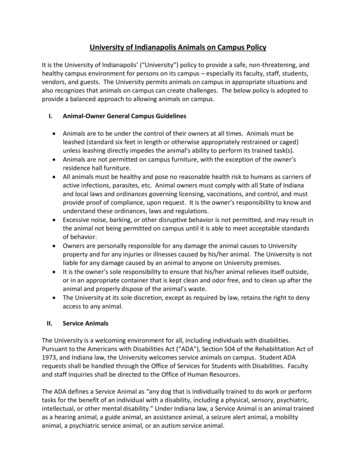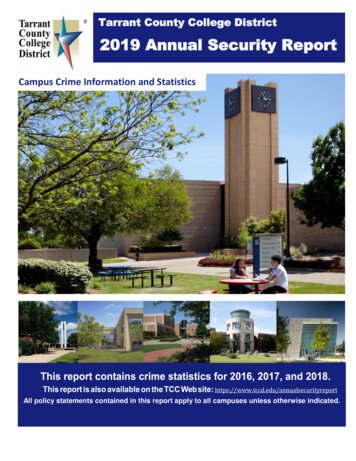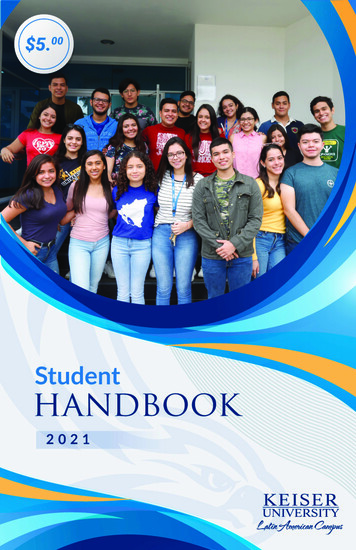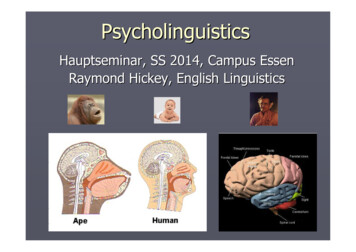
Transcription
PsycholinguisticsHauptseminar, SS 2014, Campus EssenRaymond Hickey, English Linguistics
Why should one go to a seminar on psycholinguistics?1) Language acquisition tells about the manner in which we unconsciouslylearn language in our childhood. As second language acquisition it tellsus about the way in which we can add another language to ourexisting knowledge of language. Second language acquisitionfurthermore offers insights into how two languages interact andilluminates the phenomenon of interference.2) First language acquisition reveals the stages through which we as veryyoung children go through in learning our later native language. Thesestages teach us about what areas of language are central and what areless important.3) First language acquisition offers evidence for the hypothesis of manyscientists that a certain amount of knowledge is innate (the nativiststandpoint) and not simply learned by observation and/or habit (theempiricist standpoint).
4) The order of stages is of relevance when looking at other areas oflinguistics such as language change because the division ofphenomena and categories into central and peripheral (acquisitionalhierarchy) is reflected in the types of language change which areattested in the world's languages.5) The progression of language acquisition furthermore throws light onour cognitive development and as such help us to better understandour psychological makeup.6) On a broader level, language acquisition is concerned with learningmore than one language. While monolingualism is often the rule inmodern Western societies, most of the world's population is at leastbilingual. This bilingualism has a social and an individual aspect.
Areas for presentations and term essays1) Language acquisition and related areas of development a)b)c)Biological maturation and language acquisitionLinguistic and cognitive developmentSocial aspects of language acquisition2) Acquisition of phonology/morphology3) Acquisition of syntax a)b)Single-word, two-word and complex sentencesSyntax and later language acquisition (after 5)4) Acquisition of meaning a)b)Meaning relationsExpanding vocabulary
Areas for presentations and term essays5) First and second language acquisition a) Comparing natural L1 and L2 acquisitionb) Controlled and natural L2 acquisition6) First language acquisition and other areas of linguistics (psycholinguistics, language change, speech errors, language pathology, language universals)7) Acquisition of more than one language (natural bilingualism)8) Linguistic theory and language acquisition (empricism vs. generativism)
What is psycholinguistics?Psycholinguistics is the study of language with reference to humanpsychology. It has a very broad scope but is frequently used withspecific reference to processes of language acquisition, especially ofone's first language. In the more general psycholinguistics covers thefollowing areas1) Neurolinguistics (the study of language and the brain). This has aphysical dimension to it and is the domain of neurologists concernedwith impairments of language due to brain lesions, tumors, injuries orstrokes. It also has an observational domain which is the concern oflinguists. Here certain phenomena like slips of the tongue, variousperformance errors (due to nervousness, tiredness for instance) areexamined for the insights which they might offer about the structure ofthe language faculty in the human brain.
2) Language pathology The breakdown of language has been studiedintensively from at least two main angles. The first is that of medicinewhere attempts are made to help patients regain at least partially theability to use language normally. Such patients are typically olderpeople who have had a stroke (a burst blood vessel in the brain, in thiscase affecting the Broca or Wernicke areas) or younger people whohave been involved in an accident (typically in a car or on amotorcycle) and have thus an impairment of the brain due to externalinjury. A third group is formed by patients who have had a tumor(cancerous growth) in the brain which impairs their speech pressing oneither of the speech areas (fairly rare as a medical phenomenonthough). Language disorders are known in linguistics and medicine asaphasia. There are many different types depending on the impairmentwhich a patient shows. Broca's area A part of the brain — approximately above the lefttemple — called after its discoverer the French doctor Paul Broca andwhich is responsible for speech production. Wernicke's area A part of the brain which is taken to be responsiblefor the comprehension of language. It is located just above the leftear. Named after Karl Wernicke, the German scientist who discoveredthe area in the second half of the 19th century.
Speech errors The tip of the tongue phenomenon can be seen with nonpathological speakers and is characterised by a suddenblock in lexical retrieval and which is released again for noapparent reason. Slips of the tongue involve theinvoluntary and unintended switching of elements amongwords of a sentence. Normally the onset or rhyme ofadjacent syllables are switched and this phenomenonoffers firm evidence for the validity of the syllable as aphonological unit.
Language acquisitionWhat can one learn? A child can learn any language. However, this is in general thelanguage of the parents, but this does not have to be the case. Thelanguage which the child is exposed to in the first years of life isthat which is learned. If more than one language is spoken in the environment of the childthen the child learns these languages. Two languages are not rare,three or more are unusual, however. What is important for the childis that both languages are spoken to an equal extent in theenvironment - for instance by each of the parents - and that thereare no major tensions in the relationship to the persons who speakthese languages, otherwise the child will probably develop a generaldislike of the language of this individual.
Language acquisitionThis is a process which can take place at any period of one's life. Inthe sense of first language acquisition, however, it refers to theacquisition (unconscious learning) of one's native language (orlanguages in the case of bilinguals) during the first 6 or 7 years ofone's life (roughly from birth to the time one starts school).Characteristics of first language acquisition1) It is an instinct. This is true in the technical sense, i.e. it is triggered bybirth and takes its own course, though of course linguistic input fromthe environment is needed for the child to acquire a specific language.As an instinct, language acquisition can be compared to the acquisitionof binocular vision or binaural hearing.2) It is very rapid. The amount of time required to acquire one's nativelanguage is quite short, very short compared to that needed to learn asecond language successfully later on in life.
3) It is very complete. The quality of first language acquisition is farbetter than that of a second language (learned later on in life). Onedoes not forget one's native language (though one might have slightdifficulties remembering words if you do not use it for a long time).4) It does not require instruction. Despite the fact that many non-linguiststhink that mothers are important for children to learn their nativelanguage, instructions by parents or care-takers are unnecessary,despite the psychological benefits of attention to the child.What is the watershed separating first and second language acquisition?Generally, the ability to acquire a language with native speakercompetence diminishes severly around puberty. There are twosuggestions as to why this is the case. 1) Shortly before puberty thelateralisation of the brain (fixing of various functions to parts of thebrain) takes place and this may lead to general inflexibility. 2) Withpuberty various hormonal changes take place in the body (and wetechnically become adults). This may also lead to a inflexibility whichmeans that language acquisition cannot proceed to the conclusion itreaches in early childhood.
Definitions and distinctions Acquisition is carried out in the first years of childhood and leads tounconscious knowledge of one's native language which is practically indelible.Note that acquisition has nothing to do with intelligence, i.e. children ofdifferent degrees of intelligence all go through the same process of acquiringtheir native language.Learning (of a second language) is done later (after puberty) and ischaracterised by imperfection and the likelihood of being forgotten. Learningleads to conscious knowledge. FIRST LANGUAGE ACQUISITION This is the acquisition of the mother tongue.Chronology is important here (see below). The degree of competence acquiredmay vary from individual to individual and may be checked by later switchingto another language. Note that language acquisition is largely independent ofintelligence, although individuals can and do differ in their mastery of openclasses such as vocabulary. BI- AND MULTILINGUALISM This is the acquisition of two or more languagesfrom birth or at least together in early childhood. The ideal situation where alllanguages are equally represented in the child's surroundings and where thechild has an impartial relationship to each is hardly to be found in reality sothat of two or more languages one is bound to be dominant.
SECOND LANGUAGE ACQUISITION This is the acquisition of a secondlanguage after the mother tongue has been (largely) acquired. Usuallyrefers to acquisition which begins after puberty, i.e. typically adult languageacquisition. Sometimes replaced by the term further language acquisition. ERROR This is an incorrect feature in language acquisition which occursbecause of the stage at which the child is at a given time (acquisition in asyet incomplete). Errors are regular and easily explainable. For instance theuse of weak verb forms for strong ones or the overapplication of the splural to all nouns in English would be examples of errors. Such featurestend to right themselves with time when the child appreciates that manyword classes contain a degree of irregularity. MISTAKE Here one is dealing with a random, non-systematic and usuallyunpredictable phenomenon in second language learning. Mistakes aresometimes termed 'performance errors' to emphasise that they arise on thespur of the moment when speaking and are not indicative of anyacquisitional stage. COMPETENCE is the abstract ability to speak a language, i.e. knowledge ofa language independent of its use. PERFORMANCE is actual use of language. Its features do not necessarilyreflect characteristics of performance, for example, when one is nervous,tired, drunk one may have difficulties speaking coherently. This, however,does not mean that one cannot speak one's native language.
Acquisition and learning Second language acquisition refers to a further languagewhich is acquired after the first, usually after primaryschool. The acquisition of a second language never reachesthe degree of proficiency of the first. The reason for this isthat children start too late, in fact they are usuallyteenagers before being exposed to the second language.After puberty one cannot learn a second language as wellas a first one, no matter how much time one invests inthis. In this connection linguists generally make thedistinction between acquisition - for the first language and learning - for the second language after childhood.
Conditions of acquisition NATURAL This is characterised by continuous exposure to language data. This data isnot ordered, i.e. the (child) learner is exposed to the performance of adult speakers ofthe language he/she is acquiring. There is little if any feedback to the acquirer withregard to this intake. CONTROLLED This is intervallic if not to say sporadic. Furthermore it takes place againstthe background of another language, usually the first language (L1) of the learners. Inexceptional cases acquisition can be both natural and controlled, i.e. where one obtainsformal instruction (or gives it one to oneself) and lives in an environment where thetarget language is spoken. Controlled acquisition is further characterised by an orderedexposure to the data of the language.GUIDED LANGUAGE ACQUISITION This is an intermediary type between the two justdiscussed and is characterised by prescriptive corrections on the part of the child'scontact persons, i.e. mother, father, etc. Corrections show the transfer of adultgrammars to children whereas natural language acquisition shows the gradualapproximation of the child's grammar to the adult's. Note that a child is not corrected as often by his/her mother as one mightimagine. Self-correction is most common (but not immediate) due to two factors. Mostbroadly speaking, because of lack of communication (here immediate correction maytake place) and secondly by consistently hearing correct usage on the part of themother, the child eventually drops his/her incorrect forms, which while perhapscommunicatively effective, are grammatically wrong. It is also true that children do notlearn language just from the mother. If siblings are present, then they too form a sourceof input for the child. And siblings do not correct others or simplify their language for theyounger ones among them.
The logical problem of acquisition The logical problem of language acquisition is that it would seemimpossible to learn anything about a certain language without firstalready knowing something about language in general. That is thechild must know what to expect in language before he/she can actuallyorder the data he/she is presented with in his/her surroundings andascribe meanings to words he/she encounters. THE EVIDENCE OF DEAF CHILDREN Deaf children start by babblingand cooing but this soon peters out because they have no linguisticinput. However, they would seem to seize on other communicationsystems and if people in their surroundings use sign language thenthey pick this up. The interesting point here is that the children usuallylearn the sign language more perfectly than the people from whichthey learn it (note: sign language has grammar with inflections just asdoes spoken language). They are creative in this language and createsentence structures if these are not present in their input. This wouldseem to suggest that deaf children use sign language as a medium foractivating their knowledge about language which is innate.
THE EVIDENCE OF PIDGINS Children who have very poor input in theirsurroundings tend to be creative in their use of language. Anycategories which they deem essential but which are not present in theinput from their environment are then invented by the children. Thishas happened historically in those colonies of European powers wherea generation was cut off from its natural linguistic background and onlysupplied with very poor unstructured English, Spanish, Dutch, etc. asinput in childhood. Such input, known technically as a pidgin, was thenexpanded and refined grammatically by the children of the nextgeneration and is known in linguistics as a creole. Here one can seethat if the linguistic medium of their environment is deficient childrencreate the structures which they feel are lacking, going on their ownabstract innate knowledge of language.The implication of both the above cases is that children look forlanguage and if they do not find it they create it somehow, so thatthey have a system of communication. In this sense language is a trueinstinct because it starts to develop of its own accord and does notneed to be consciously triggered.
IS THERE A LANGUAGE GENE? There is a pathological medical condition calledSpecific Language Impairment (abbreviated SLI) which covers a range ofdefects, all of which have in common that children continually makegrammatical mistakes in their mother tongue, i.e. they would seem to beunaware of the existence of grammatical rules. Now as the Canadian linguistMyrna Gopnik has shown in her study of a family in Britain, some 16 of 30members over three generations suffered from the defect. This would seem toimply that it is genetically transferred (it looks like a defective gene which isdominant in the family) which would also imply that the ability to grasp therules of grammar in first language acquisition is genetically encoded. IS THE LANGUAGE FACULTY SEPARATE FROM OTHER COGNITIVE ABILITIES?There is one major piece of evidence that this is the case. Williams syndromeis a medical condition in which the patients are quite severly retarded, as bothchildren and adults, and have difficulties counting properly or carrying outsimple tasks like tieing their shoelaces. However, such people are goodspeakers of their native language and just show a slight tendency toovergeneralise (they might say speaked for spoke). They have a goodcommand of grammatical rules which shows that their language faculty isintact. The implication of this is that our ability to speak language is separatefrom other cognitive abilities.
How is language transmitted? Language is obviously passed on from parents to their children. But on closerinspection one notices that it is the performance (in the technical sense) of theprevious generation which is used as the basis for the competence of the next.To put it simply, children do not have access to the competence of theirparents.1)2)3)Linguistic input from parents (performance)Abstraction of structures by childrenInternalisation (competence of next generation) The above model is the only one which can account for why children can laterproduce sentences which they have never heard before: the child stores thesentence structures of his/her native language and has a lexicon of words aswell. When producing new sentences, he/she takes a structure and fills it withwords. This process allows the child to produce a theoretically unlimitednumber of sentences in his/her later life.Note that certain shifts may occur if children make incorrect conclusionsabout the structure of the language they are acquiring on the basis of whatthey hear. Then there is a discrepancy between the competence of theirparents and that which they construct; this is an important source of languagechange.
Language acquisition for any generation of childrenconsists of achieving mastery in four main areas, i.e.acquiring:1) A set of syntactic rules which specify how sentences arebuilt up out of phrases and phrases out of words.2) A set of morphological rules which specify how words arebuilt up out of morphemes, i.e. grammatical units smallerthan the word.3) A set of phonological rules which specify how words,phrases and sentences are pronounced.4) A set of semantic rules which specify how words, phrasesand sentences are interpreted, i.e. what their meaning is.
Competence and Performance competence According to Chomsky in his Aspects of thetheory of syntax (1965) this is the abstract ability of anindividual to speak the language which he/she has learnedas native language in his/her childhood. The competenceof a speaker is unaffected by such factors as nervousness,temporary loss of memory, speech errors, etc. These latterphenomena are entirely within the domain of performancewhich refers to the process of applying one's competencein the act of speaking. Bear in mind that competence alsorefers to the ability to judge if a sentence is grammaticallywell-formed; it is an unconscious ability. performance The actual production of language asopposed to the knowledge about the structure of one'snative language which a speaker has internalised duringchildhood.
Stages of language acquisition One of the firmest pieces of evidence that language acquisition isgenetically predetermined is the clear sequence of stages whichchildren pass through in the first five years of their lives. Furthermorethere are characteristics of each stage which always hold. For instanceup to the two-word stage only nouns and/or verbs occur. No childbegins by using conjunctions or prepositions, although he/she will haveheard these word classes in his/her environment. Anothercharacteristic is overextension. Children always begin acquiringsemantics by overextending meaning, for instance by using the worddog for all animals if the first animal they are confronted with is a dog.Or by calling all males papa or by using spoon for all items of cutlery.The generalisation here is that children move from the general to theparticular. To begin with their language is undifferentiated on alllinguistic levels. With time they introduce more and more distinctionsas they are repeatedly confronted with these from their surroundings.Increasing distinctions in language may well be linked to increasingcognitive development: the more discriminating the child's perceptionand understanding of the world, the more he/she will strive to reflectthis in language.
0)1)2)0.0 - 0.30.4 - 0.50.10 - 13)2.64)5)3.05.0Organic sounds, crying, cooingBeginning of the babbling phaseThe first comprehensible words. Afterthis follow one-word, two-word andmany-word sentences. The only wordstages is known as the holophrasticstage; Telegraphic speech refers tospeech with only nouns and verbs.Inflection occurs, negation, interrogativeand imperative sentencesA vocabulary of about 1000 wordsThe main syntactic rules have beenacquiredThese divisions of the early period of first languageacquisition are approximate and vary from individual toindividual.
Insights from language acquisitionUnconscious knowledge For the linguist the metaphor of the iceberg is veryuseful: nine tenths of language is under the surface.For instance, none of the present public wouldprobably be in a position to list and describe thesentence structures of their native language.Nonetheless you use these hundreds of times each dayin well-formed sentences. Perhaps a medicalcomparison might be helpful here: you use the musclesof your body constantly in order to move your limbs orto keep your balance while standing. You can do thatwithout knowing how it works. But your centralnervous system 'knows' how the muscles areinnervated.
Insights from language acquisitionOne can recognise here that there are two types ofknowledge: knowledge which one can express in words e.g. the rules of chess - and unconscious knowledgewhich is activated without reflection, for instance, whenspeaking your native language. Such unconsciousknowledge is based on the internalisation of languagestructures which we extracted from our environment aschildren.InputLanguage in our surroundingsAction by child(i)(ii)extraction of structuresstorage in long term memory asunconscious knowledge
Insights from language acquisitionLanguage as an instinct, as an innate faculty An instinct is a tendency to do something which whentriggered in childhood cannot be rejected, it is not amatter of conscious decision. For instance, there is noadult who crawls around on all fours, we cannot refuseto walk upright because this is an instinct. Thedevelopment of an instinct takes place immediatelyafter birth and is completed quickly.
Insights from language acquisitionIf one applies this view to language acquisition then one canmaintain the following.1) No child makes a conscious decision to learn a language.2) No child has ever refused to learn the language spoken in his/herenvironment.3) Acquisition is unconscious and can be compared with the unfoldingof other instincts, for instance that of binaural hearing or telescopicvision.Linguists furthermore assume that we know what language is andhow we are to react to it, i.e. by acquiring it. To put it simply: thelanguage faculty is innate so that the child can immediately processthe language he/she hears in the surroundings. The child must notwait for instructions from the parents before acquiring his/her nativelanguage.
Insights from language acquisitionThe decline in the ability to learn languageIn general one can maintain that after puberty the ability to acquire alanguage - in the technical sense of learning with native speakercompetence - drops off radically and is never gained again. Thereare two major hypotheses about why this should be the case. Thehypotheses may well be related to each other.1) Due to the lateralisation of the brain - shortly before puberty - thebrain loses flexibility and receptiveness, at least for unconsciouslearning. By lateralisation one means the fixing of functions of thebrain to one half only.2) With sexual maturity at puberty strong hormonal changes take placewith humans. These lead to a reduction of the playful elementwhich is typical of children. The spontaneous behaviour of childrendecreases drastically with the onset of puberty. A certain rigidity ischaracteristic of adults vis a vis children and this also affects theability to learn languages.
Insights from language acquisitionWhat do we know at the end of the day?Now we can view the stages of native language acquisition in moredetail.1) Children hear fragments of language in their environment. Theythen abstract the underlying structures behind what they hear.2) Children then internalise the structure they gained - for instance thestructures of sentences - and later on they use these when theywish to form new sentences without considering whether they haveheard an actual sentence before or not. This process is calledsentence generation in linguistics.
Contrasting features of first and secondlanguage acquisitionFLAno conscious choicevery rapidno instructionhigh competence reachedSLAchoice made by learnerrelatively slowinstruction is usualcompetence attained varies greatlyPossible reasons for differences between FLA and SLASLA occurs against the background of FLA (interference hypothesis)FLA takes place before puberty (adulthood)FLA takes place before lateralisation of brain (just before puberty)
Recommended literatureAitchison, Jean 1998. The articulate mammal. An introductionto psycholinguistics. London: Routledge.Clark, Herbert H. 1996. Using language. Cambridge:University Press.Fletcher, Paul and Michael Garmon (eds) 1979 and laterLanguage acquisition Cambridge: University Press.Gregory, Richard L. (ed.) 1987. The Oxford companion to themind. Oxford: University Press.Lust, Barbara and Claire Foley (eds) 2004. Languageacquisition: The essential readings. Malden, MA: Blackwell.Steinberg, Danny 1993. An introduction to psycholinguistics .London: Longman.
Areas for presentations and term essays 1) Language acquisition and related areas of development a) Biological maturation and language acquisition b) Linguistic and cognitive development c) Social aspects of language acquisition 2) Acquisition of phonology/morphology 3) Acquisition of syntax a) Single-word, two-word and complex sentences b) Syntax and later language acquisition (after 5)



